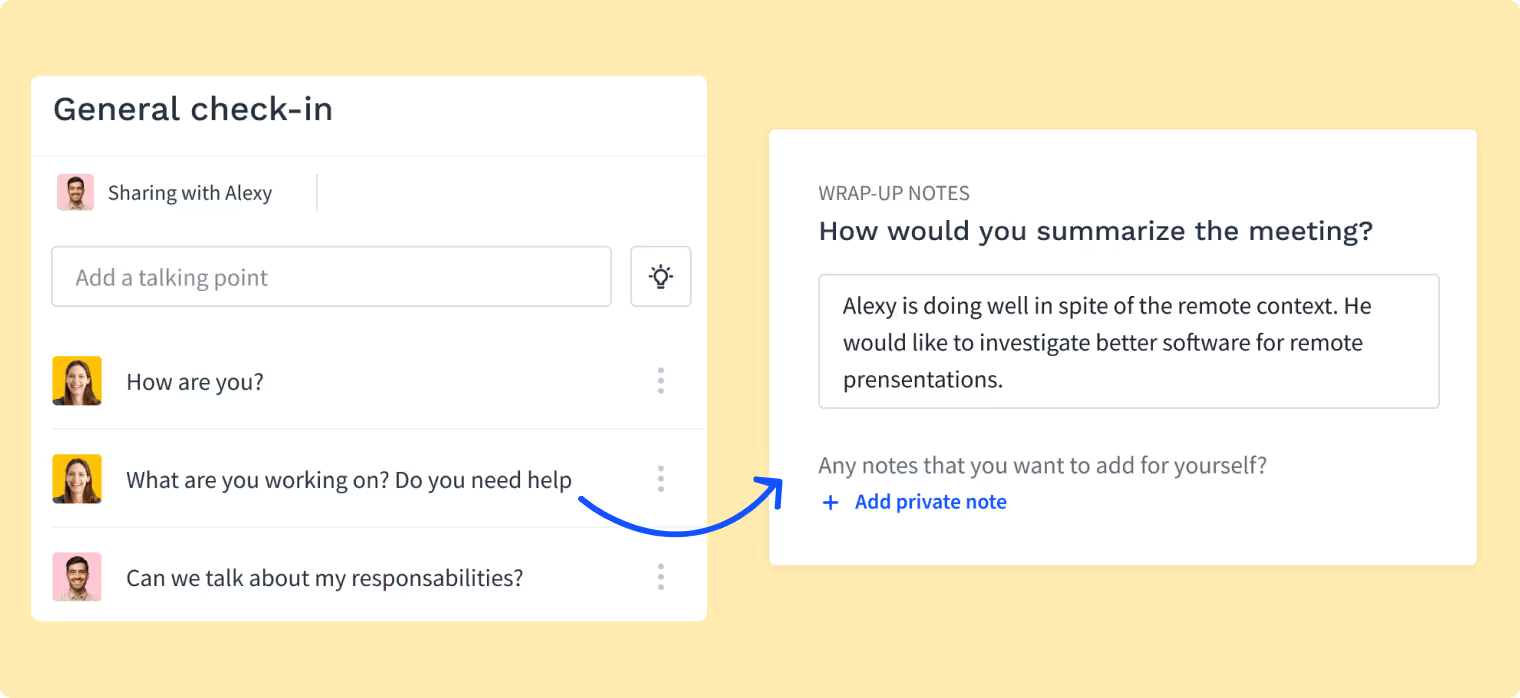Nonverbal communication in the workplace: a key skill for managers

Discover Workleap Officevibe's benchmark report on 12 key employee engagement metrics

Being an impactful manager, and a clear communicator goes hand in hand. A major proponent to effective communication extends beyond what managers say to how they say it. The inadvertent cues we give off with our body language affect how our messages are received by our audience, which can in turn affect relationships. This is referred to as nonverbal communication in the workplace.
Simply put: nonverbal communication is a crucial communication skill for managers and teams to consider.
{emphasize}
It’s estimated that roughly 55% of what we say is based upon our body language alone.
{emphasize}
Focusing on nonverbal communication in the workplace builds strong teams that learn to understand each other beyond verbal messaging.
This means, while your team is listening to the words you’re saying, nonverbal cues contribute to how your message is received and vice versa. The tricky part is unpacking how you and your team communicate nonverbally and what type of dynamic ensues as a result.
That’s why we’re diving into how managers can adopt nonverbal communication tips that they can distill to their team.
Why nonverbal communication in the workplace is important
Nonverbal communication in the workplace means being mindful of what we say just as much as how we say it. Our body gives off nonverbal signals which may tell a different story. So, what does that mean? What we communicate extends beyond the spoken word.
Our body language tells us a lot about ourselves, and indicates levels of engagement, motivation, and support within our team. There are a myriad of cues that indicate whether a dynamic is positive or needs improvement. Note that these can change, depending on the environment we find ourselves in (remote or in-person).
Examples of nonverbal communication skills include:
- Gestures and mannerisms: They help us play out thoughts and they're important to keep in mind as they can be distracting or give off false impressions.
- Eye contact: Use eye contact to establish connections with people and emphasize that you’re listening.
- Tone of voice: Our tone is associated with different emotions such as anger, fear, excitement, joy, etc.
- Posture: The way we hold ourselves gives off cues a to whether we are engaged in the conversation.
- Facial expressions: The expressions on our faces in a conversation can say how we feel before we have the chance to speak.
Nonverbal communication functions on 3 key levels:
1. Reinforces verbal communication
Nonverbal cues and gestures can complement or accent our verbal messages.
For example, a gesture such as banging a fist on your desk while yelling underlines the emotion of anger. On a more positive note, you can use your hands while explaining a project or presenting a pitch to demonstrate your enthusiasm. Using your hands makes your words more memorable.
2. Substitutes verbal communication
Nonverbal cues can also stand in for a verbal message.
We don’t always need to speak to say something. The expression “a picture is worth a thousand words” more or less sums it up. Facial expressions are universal. We can read feelings on a face – so much so that we can even detect when a smile is “fake”. We can perceive authenticity, which is why it’s so important for you as a manager to be self-aware of the signals you emit. If your people see you as inauthentic, it will be difficult to get them to move in the direction you want them to.
With self-awareness, you’ll also be able to understand and read others’ nonverbal messaging – the story behind the story – which is helpful in building and maintaining authentic relationships.
{emphasize}
Tip: Smile in the morning when you walk by people in the office. You may not have time for a chit chat but letting people know you’re happy to be at work with them will create a contagion of positivity and help form a positive impression without ever saying a word.
{emphasize}
3. Contradicts verbal communication
Most importantly, our nonverbal cues can contradict our verbal messages.
This is the one that managers need to pay particular attention to at work because contradictory communication breeds distrust and leads your employees to question your credibility.
It’s the great responsibility of a leader to express themselves clearly and impart their intended message with coherence. Saying one thing and doing another is a big leadership faux pas that we want to help you avoid.
Let’s look at a real-life example: You want to encourage your team to get on board with a change in the company. To do this, you need to express your own excitement about it. While your words hit the nail on the head, your arms are crossed, your voice is low and you’re resting back in your chair like it’s naptime. The outcome is that your team won’t be on board with the change, and they’ll perceive your mixed message as a sign of untrustworthiness.
{emphasize}
Takeaway Tip: The first step to getting nonverbal right is learning to manage stress. When we’re stressed, our bodies become the outward image of our inward emotions, which affects your body language and the message you (inadvertently) give off. This article on managing stress might help.
{emphasize}
The secret ingredient to nonverbal communication
Can you guess? It’s Self-Awareness; the first, foundational domain of Emotional Intelligence.
As a leader, your people skills or EQ have a much greater bearing on your success than your hard skills (IQ) because at the end of the day your job is about people – the heart of every organization.
The first step is understanding self. We’d all like to think that we have a solid grasp on our emotions, how we handle them and how they affect others, but in reality being self-aware is no easy task. It is, however, an important one, and very luckily, one that can be learned.
If you want to send the right nonverbal message, you need to first be aware of your emotions and understand how they impact you – inside and out. For example, we know that our internal stress affects our external body language. If we learn to be aware of how we’re feeling and what triggers our stress, we can better control it – and the way our body reacts.
{emphasize}
Tip: Ask yourself questions like: What triggers you? What situations make you feel certain emotions? Does your body language change with these feelings? Keep track of these emotions in a daily journal and then search for patterns. Understanding is the first step to improving.
{emphasize}
6 nonverbal communication tips for managers and teams:
There are several ways managers and teams can improve their nonverbal communication cues. We’ve listed the most prevalent ones below which are also applicable for remote work.
1. Be mindful of posture and gestures
When we indicate that we’re motivated, ready to learn and eager to listen, our body language expresses this for us. We tend to sit up straight, lean into a conversation (or towards your screen if you’re working remotely). Positive body language means your posture is open and ready to receive information. It’s a dance between listening and contributing to the conversation. Your posture and gestures encourage others to share their insight while giving you the ability to contribute as well.
{emphasize}
Tip: Demonstrate active listening and engagement by keeping your shoulders back, and sitting up tall. If you’re not comfortable, call it out: Let your team know that you’re paying attention despite external circumstances.
{emphasize}
2. Establish eye contact
Establishing eye contact may sound like a no brainer, yet it’s something all managers may struggle with. First, being a new manager may incite a level of imposter syndrome making it difficult to assert your presence or make a team member feel supported by an authority figure. A key way to make sure your team knows that you’re present during meetings is to establish and maintain eye contact. Secondly, as an established manager, be sure to maintain eye contact further demonstrating you’re focused and present.
{emphasize}
Tip: Look directly into the camera if you’re working remotely and mute alerts during meetings. If you’re expecting an important or urgent call, let your team know that this is the reason your alerts are active.
{emphasize}
3. Adopt an appropriate tone
Have you ever answered a question in a way that made it sound as though you were upset, but you weren’t? These awkward situations make us human, and they’re important to take note of. Tone of voice indicates the level of stress of any given situation as well as emotions about circumstances. When you learn to manage your tone with your team, you set the bar for the type of conversations you’ll have. Certain intonations are helpful for some situations while others may not be conducive to productivity.
{emphasize}
Tip: Adapt your tone of voice to the situation you find yourself in. If a member of your team is having a personal crisis, your tone will set the bar for them to confide in you, further solidifying trust. Contrarily, if a team hasn’t met their objectives, balance your tone to be both confident and managerial.
{emphasize}
4. Look out for exaggerated sighs
The current workplace landscape has changed significantly over the course of the last year. These massive global changes have increased stress levels which can often surface during workplace conversations. That’s why it’s important to note how sighing during an important announcement might deliver the wrong message to your team.
Sighs may also be a sign of stress, fatigue, or disinterest. On the other hand, gasps can signal stress, anger or frustration.
{emphasize}
Tip: Keep a keen eye out for these subtle reactions. Notice if you or your employees communicate with sighs or gasps during meetings. If this is a frequent part of daily interactions, schedule 1-on-1 time to talk about it. Your employees value having their voices heard, they may simply not know how to express it.
{emphasize}
5. Maintain receptivity and openness
When it comes to receiving information, our body language says a lot about us. Whether we’re sitting with our arms and legs crossed, or leaning back in our chair, away from the person who’s speaking. On the surface these mannerisms might have to do with circumstantial aspects. For example, we tend to cross our arms if the temperature of a room is cold, or lean back to feel comfortable. Yet, these are also indicators as to whether or not people are paying mindful attention, are upset, or even uninterested in a topic.
{emphasize}
Tip: Keep your body language open by uncrossing your arms, and leaning slightly forward. Make sure your team knows you're actively listening with open and receptive body language
{emphasize}
6. Be mindful of facial expressions
How our face changes while we speak might be telling a story that differs from the one we are verbally communicating. Being mindful of our expressions, helps. This helps managers stay present and adapt facial expressions in alignment with the areas of discussion. As a result, it establishes cohesiveness, and understanding to help others understand our key messages.
{emphasize}
Tip: When employees share news that may be shocking or stressful, remember that your facial expressions will impact the way people feel. If a topic sounds unclear, before grimacing or reacting quickly, take the time to pause and ask thoughtful questions to learn more.
{emphasize}
Each of these points are helpful when conducting important conversations with your team. They contribute to the way we build connections with each other, especially during a time where we may feel disconnected or siloed. Officevibe is a one on one meeting software that helps managers apply each point listed above. We help you get prepared and take action with humility and authenticity, setting you and your team up for success.

Where nonverbal communication can go wrong
Nonverbal communication is powerful, for better or for worse.
Here’s how it can backfire:
False Impressions
You can give off impressions without intending to. For example, if an employee is resting his face in the palm of his hand during a meeting he’ll be showing that he’s bored, when in reality he might be thinking the complete opposite. Maybe he’s tired, or maybe that position helps him focus. It goes to show how quickly we make assumptions, and that it’s important to dig deeper than what we see. Don’t always believe everything you think.
Credibility Crusher
If your nonverbal language tells a different story than your spoken language – the “mixed-message” dilemma – people might question your credibility. For example, if you’re giving positive feedback to an employee but you relay the good news with a low, monotone voice – they likely won’t believe your words, and may lose confidence in you.
When you take the time to match your nonverbal messaging to your words when giving positive feedback you’ll see wonderful results. To deliver good news and have it perceived as genuine, sit forward when you speak and smile! If employees accept that your praise as sincere, they’ll feel more encouraged to keep up the good work.
Don’t worry – we’ll shed light on each type of nonverbal communication so you can set yourself up for success with every personal encounter.
How to build effective teams based on nonverbal communication
Employees learn from their managers, which is why it’s important to lead by example when it comes to nonverbal communication style and techniques.
When you notice how members of your team are not displaying engaged or positive body language, schedule some 1-on-1 time to talk about it.
Learning about your team's nonverbal cues will shed light on other factors that may not be prevalent during meetings. These can be cultural, environmental and personal concerns contributing to misconstrued perceptions. Knowing this helps managers prevent unnecessary conflicts within the team. It’s especially important for remote teams since our environments and circumstances differ greatly.
At the end of the day, everyone is different and the way they communicate tells their story differently. Being mindful of our own nonverbal communication habits helps us be more aware of others. When managers understand their employees, they can identify their needs and build a better relationships with their team.
Give HR and managers the clarity, confidence, and connection to lead better every day.


%20(1).avif)


.avif)
.avif)








